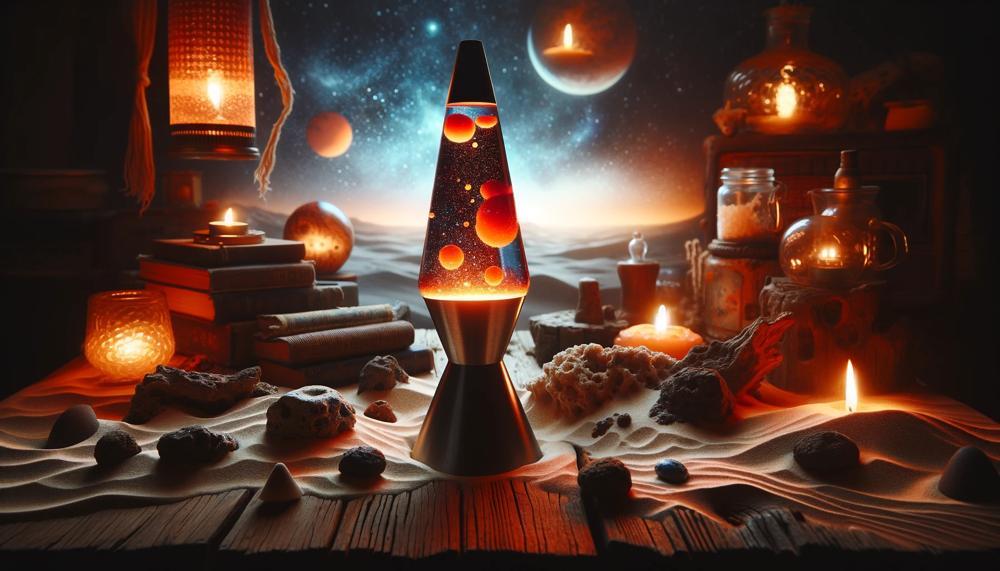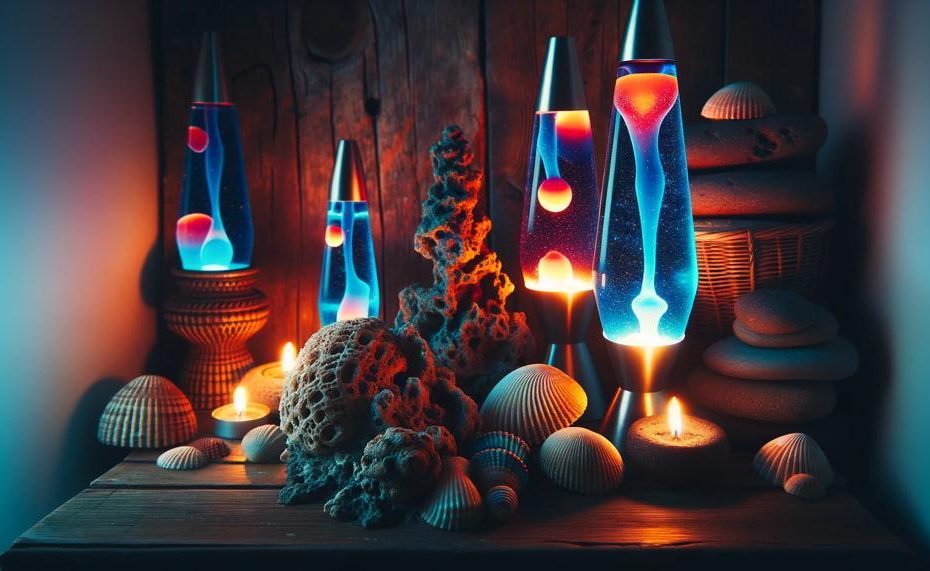For decades, lava lamps have been a beloved fixture in homes and offices, captivating us with their hypnotic and vibrant display. But as we watch the wax blobs dance and swirl, it’s natural to wonder: can these iconic lamps actually expire? The answer may surprise you.
In this blog post, we’ll delve into the longevity of lava lamps and uncover the truth behind their potential expiration date. So, can lava lamps go bad?
Yes, lava lamps can go bad:
- Cloudy: Lava lamps can become cloudy if they have been shaken or moved while hot, or if the bottle is about 2,000 hours old. This is often irreparable, but you can run the bottle a few times to see if it improves the situation. You can also try rinsing the bottle to get rid of any remaining cloudiness.
- Die: Lava lamps contain an incandescent bulb, which is normally made for ovens. After about 2,000 hours of use, the lamp will die. You can unscrew it and take it to a lighting shop, lowes or home depot and get a replacement of the same wattage and voltage.
- Wax damage: Running lava lamps too long or leaving them in direct sunlight can damage the wax. However, you can actually restore worst case.
Contents
Do Lava Lamps Go Bad?
The deterioration of a lava lamp can be attributed to various factors such as overheating, reaching its lifespan of 2000 hours, and improper usage. To ensure that your lava lamp lasts for a long time, it is essential to use it responsibly and follow the guidelines provided by the manufacturer.
| Possible Causes of Lava Lamp Deterioration | Tips to Extend its Lifespan |
| Overheating | Avoid leaving the lamp on for extended periods and keep it away from heat sources. Follow the manufacturer’s instructions for proper usage. |
| Reaching its lifespan of 2000 hours | Replace the lamp when it reaches its expiration date. Signs of a deteriorating lamp include cloudy liquid, faded wax, and complete malfunction. |
| Improper usage | Handle the lamp with care and avoid moving it when hot. Use it for 1-2 hours at a time and keep it away from heat sources like radiators. |
Furthermore, regular maintenance is crucial in prolonging the lifespan of a lava lamp. This includes cleaning the glass globe regularly and ensuring that the lightbulb is functioning properly. If your lava lamp is over 10 years old, it is recommended to have it checked by a professional for safety purposes.
How Long Can a Lamp Stay On?
The suggested duration for using a lava lamp is eight to ten hours. Exceeding this time frame could result in overheating and potential malfunction. This is due to the heat emitted from the lightbulb at the base of the lamp, which causes the wax inside to melt and create the mesmerizing lava-like effect.
However, if the lamp is left on for an extended period, the wax can overheat and become too thin, affecting its ability to rise and fall properly.
| Duration | Effect on Lava Lamp | Action Needed |
| 8-10 hours | Suggested maximum use time | Unplug and allow for cooling before reusing |
| 10-12 hours | Possible overheating and malfunctioning of lamp | Immediately unplug and let it cool down before using again |
| 12+ hours | Likely overheating and damage to lamp | Immediately unplug, allow for cooling, and consider replacing the lamp |
It is essential to keep in mind that while leaving a lava lamp on for longer periods can lead to overheating and damage, it does not necessarily mean that the lamp will malfunction after a specific number of hours. With proper maintenance and care, a lava lamp can last for several years.
However, there are indications that it may be time to replace your lava lamp. These include cloudy liquid or wax, slow or no movement of wax blobs, or discoloration of the liquid. If you notice any of these signs, it is recommended to replace the lamp as it may not be functioning correctly and could pose a safety hazard.
How Many Years Do Lava Lamps Last?
The longevity of a lava lamp can vary depending on several factors, such as how often it is used, how well it is taken care of, and the quality of the product. Generally, a well-maintained lava lamp can last anywhere from 2-5 years.
Factors that impact the lifespan of a lava lamp:
- Usage: As previously mentioned, it is crucial to limit the usage of your lava lamp to 8-10 hours at a time. Using it continuously for longer periods can cause the wax to overheat and lose its mesmerizing motion. It is also recommended to switch off the lamp when not in use to conserve energy and extend its lifespan.
- Maintenance: Regular maintenance is essential to ensure your lava lamp remains functional for years to come. This includes replacing the bulb when it burns out, regularly cleaning the glass container and base, and checking for any signs of damage or malfunction.
- Product Quality: Like any other appliance or decorative item, the quality of a lava lamp can significantly affect its lifespan. Investing in a high-quality lava lamp from a reputable brand can increase its durability and longevity.
Tips for prolonging the lifespan of your lava lamp:
- Avoid shaking or moving the lamp while it is in use.
- Keep it away from direct sunlight or sources of heat.
- Use distilled water instead of tap water to prevent mineral buildup.
- Replace the bulb with one that has a similar wattage when needed.
- Store it in a safe place when not in use.
How To Know It’s Time For a Replacement?
It may be time for a replacement. Here’s how to know when it’s time to switch out your old lamp for a new one:
Check for the metal coil at the bottom
A vital component of a lava lamp is the metal coil at the bottom that helps melt the wax and create its iconic lava-like movement.
If this coil is not visible, gently rotate the globe until it drops into place. If the lamp still doesn’t work, it’s time to consider a replacement.
Observe the shape of the lava
If the lava in your lamp appears to be forming a dome shape, it may be overheated. In this case, turn off the lamp and allow it to cool down before using it again.
If the issue persists, it’s best to replace the lamp altogether.
Check the bulb
If your lava lamp won’t turn on or produce any light, it could be due to a dead bulb. Try replacing it with a new one and see if that solves the issue.
If not, there may be other underlying problems that require a replacement.
Evaluate its surroundings
To ensure optimal performance, keep your lava lamp away from direct sunlight, drafts, and cold temperatures.
If you notice any of these factors affecting your lamp, relocate it to a more suitable location.
Look for signs of wear and tear
Over time, lava lamps can show signs of wear and tear such as cloudy liquid or faded wax. These are indications that it may be time for a replacement.
Remember to always handle your lava lamp with care and follow safety precautions to prolong its lifespan.
Do Lava Lamps Ever Stop Working?
Lava lamps can cease functioning for various reasons, such as a burnt-out lightbulb or a damaged seal. The flow of lava may also become less active over time, resulting in a malfunctioning lamp. Regularly checking and maintaining your lava lamp is crucial to ensuring its proper functioning. Here are some common causes of lava lamp malfunctions:
- Burnt-Out Lightbulb: The lightbulb is a vital component of a lava lamp as it provides the heat needed for the lava to flow. Over time, the lightbulb can burn out and will need to be replaced. This is a simple fix that can be solved by purchasing a replacement bulb.
- Damaged Seal: The seal at the base of the lava lamp is essential for keeping the liquid and electrical components inside. If the seal becomes damaged or worn out, it can cause leakage, which can damage the electrical components and lead to a malfunctioning lamp. Regularly check for any signs of damage or leaks at the base of your lava lamp.
- Inactive Lava Flow: As mentioned before, the lava flow is what creates the mesmerizing effect of a lava lamp. Over time, the flow may become less active due to factors like temperature changes or mineral buildup in the liquid. This can result in a malfunctioning lamp and may require troubleshooting or maintenance to restore its normal flow.
- Expired Lifespan: Like any electronic device, lava lamps have a limited lifespan and will eventually expire after a certain number of hours of use. On average, most lava lamps are expected to last around 2,000 hours before needing to be replaced. Keep track of how long you’ve had your lava lamp and consider replacing it if it’s nearing its expiration date.
- Poor Maintenance: Lastly, neglect and poor maintenance can also cause a lava lamp to malfunction. It’s essential to regularly clean and maintain your lava lamp to ensure its proper functioning.
Is It Safe To Use An Old Lava Lamp?
While they can be with proper maintenance and caution, there are potential hazards to keep in mind. These hazards include leaks, overheating, and exposure to harmful chemicals. We’ll break down each one so you can enjoy your old lava lamp safely.
Leaks – The Potential Mess
Lava lamps, especially older ones, tend to leak if not properly maintained. This can be a messy problem if the seal is damaged or the lamp is knocked over.

To avoid any slips or falls, regularly check the seal and handle with care.
Overheating – A Real Concern
With wear and tear, old lava lamps have a higher risk of overheating, which can cause the glass to crack or shatter.
To prevent this dangerous situation, limit usage to six hours at a time and keep away from direct sunlight or heat sources.
Exposure to Harmful Chemicals – What You Need to Know
While modern lava lamps do not contain the toxic compound carbon tetrachloride, older lamps may still have it. In case of a break or damage, caution is crucial as it can expose you to harmful chemicals. Make sure to dispose of the lamp properly.
Conclusion:
In conclusion, don’t let these potential hazards discourage you from using your old lava lamp. With proper care and maintenance, along with handling and disposal precautions, you can safely enjoy its mesmerizing display.
Can Lava Lamps Explode?
When it comes to lava lamps, there are certain safety concerns that you should be aware of. While they are generally safe if used correctly, there are some risks associated with their use.
These include the possibility of burns and fire hazards if proper care is not taken.
One of the main safety concerns when using a lava lamp is the risk of leaks, overheating, and exposure to potentially harmful chemicals. This is because lava lamps contain hot wax and liquid that can cause burns if touched.
In addition, the bulbs used in these lamps can become very hot and pose a fire hazard if not handled with caution.
Research has shown that there have been rare instances of lava lamps exploding, but these incidents can often be attributed to human error or improper use. For example, leaving the lamp on for too long can cause the wax and liquid to overheat and expand, leading to a potential explosion.
Another common cause is using the wrong type of bulb or one with a higher wattage than recommended.
Furthermore, placing a lava lamp in direct sunlight or near a heat source can also increase the risk of explosion. It is crucial to follow the manufacturer’s guidelines for proper usage and maintenance to avoid any potential dangers.
Conclusion
To wrap it up, the longevity of lava lamps may not be set in stone, as external factors like sunlight and temperature can impact their lifespan.
But with proper upkeep and attention, these beloved lamps can light up your space for years to come. Just keep an eye out for any signs of wear and tear, and don’t hesitate to replace them if needed.





